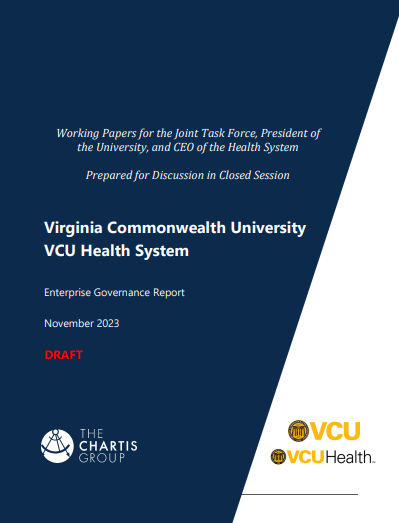
Site prep for demolition of the Public Safety Building has ramped up in recent weeks. (BizSense file photo)
Calls for changes to VCU Health’s governance structure in light of a failed and costly downtown development are increasing with the release of a board-commissioned report from a healthcare consulting firm.
The governing boards for Virginia Commonwealth University and the VCU Health System Authority on Tuesday released the report from The Chartis Group, a national firm they hired to review the health system board’s makeup and advise on “the alignment between” the two boards.
The firm’s review, conducted from May to September, followed the demise of the so-called Clay Street project – a $325 million redevelopment of Richmond’s old Public Safety Building that the health system backed out of as the project’s master tenant, at a cost of $73 million and counting.
The boards received the report Monday in an hours-long closed session, after which they agreed to release the report to the public after submitting it to the governor’s office and the Joint Legislative Audit & Review Commission, the state’s investigative arm that a week earlier committed to studying the health system in light of the aborted development and the controversial exit payment.
At the start of Monday’s meeting, Todd Haymore, rector of the VCU Board of Visitors, acknowledged JLARC’s decision before going into the closed session.
“We fully will cooperate in that process. In fact, we welcome it,” Haymore said, adding that the Chartis Group report “will be helpful to the process.”
In a letter to General Assembly leadership in September, Gov. Glenn Youngkin urged legislators to make changes to VCU Health’s governance structure, including the replacement of VCU President Michael Rao as chairman of the authority’s Board of Directors. Rao has said he supports Youngkin’s thinking on the matter.
The authority’s bylaws currently mandate that the university president serve as the health system board’s chairman. Rao also serves as president of the health system.
The report from Chartis Group agrees with Youngkin’s recommendation that the university president should instead continue serving on the board as an ex officio member, and not be mandated to serve as chair. The board would instead select a chair, with the VCU president eligible for consideration.
The report states that interviews conducted by Chartis Group with about 40 stakeholders across VCU and VCU Health “consistently indicated a preference that the VCU President not also serve as the VCUHS Board Chair.” It also notes “a widely perceived lack of transparency and coordination between the VCU and VCUHS Boards,” adding: “The Clay Street project was the most commonly cited example.”

A rendering of the so-called Clay Street project that would have replaced the Public Safety Building. (BizSense file)
Chartis Group’s other recommendations include exploring the feasibility of structuring VCU Health as a subsidiary of VCU, and increasing health system board member terms from three to four years. The report suggested making other enhancements to the board’s composition “to gain the expertise necessary to govern an academic health system with VCUHS’s scale and complexity,” noting its $3 billion in annual revenue.
Also recommended is a coordinating committee for the two boards “to ensure alignment and communications on strategic direction and key decisions,” and the addition of a senior operating executive for VCU Health, allowing the health system CEO to focus on strategic direction and implementation.
VCU Health’s governance structure was compared to other public universities with academic health enterprises, including: UW Health in Wisconsin, in which the university and health system are independent affiliates similar to VCU’s; UNC Health, in which the health system is a subsidiary of the university; and UVA Health and UM Health in Michigan, both of which structure the health system as an operating division of the university. The UNC Health model is recommended for VCU.
“The key finding is that there is a compelling case for change in the organizational structure and Board composition of VCUHS to better align VCU and VCUHS for long term success,” the report states, adding that such change would likely take several years to achieve with legislation introduced over multiple General Assembly sessions.
The report concludes with a section reiterating that there is “a compelling case” for VCU Health to change its structure to become a subsidiary of VCU and to enhance its board makeup, citing the Clay Street project as a case in point.
“Recent events, such as the Clay Street real estate transaction, have clearly demonstrated a foundational lack of alignment between VCU and VCUHS and has illuminated existing gaps in the Board’s composition with regard to several key areas of expertise,” the report states.
It adds that implementing the recommendations will be contingent on, among other factors, “buy-in from the legislature” and “a shift in culture and communications across VCU and VCUHS at all levels to promote collaboration.”
Chartis Group produced its report on a contract with VCU and VCU Health that allowed payment of up to $456,000, the university and health system said. The report followed an after-action review the boards commissioned from law firm Saul Ewing, which was paid more than $342,000 for its work.

Site prep for demolition of the Public Safety Building has ramped up in recent weeks. (BizSense file photo)
Calls for changes to VCU Health’s governance structure in light of a failed and costly downtown development are increasing with the release of a board-commissioned report from a healthcare consulting firm.
The governing boards for Virginia Commonwealth University and the VCU Health System Authority on Tuesday released the report from The Chartis Group, a national firm they hired to review the health system board’s makeup and advise on “the alignment between” the two boards.
The firm’s review, conducted from May to September, followed the demise of the so-called Clay Street project – a $325 million redevelopment of Richmond’s old Public Safety Building that the health system backed out of as the project’s master tenant, at a cost of $73 million and counting.
The boards received the report Monday in an hours-long closed session, after which they agreed to release the report to the public after submitting it to the governor’s office and the Joint Legislative Audit & Review Commission, the state’s investigative arm that a week earlier committed to studying the health system in light of the aborted development and the controversial exit payment.
At the start of Monday’s meeting, Todd Haymore, rector of the VCU Board of Visitors, acknowledged JLARC’s decision before going into the closed session.
“We fully will cooperate in that process. In fact, we welcome it,” Haymore said, adding that the Chartis Group report “will be helpful to the process.”
In a letter to General Assembly leadership in September, Gov. Glenn Youngkin urged legislators to make changes to VCU Health’s governance structure, including the replacement of VCU President Michael Rao as chairman of the authority’s Board of Directors. Rao has said he supports Youngkin’s thinking on the matter.
The authority’s bylaws currently mandate that the university president serve as the health system board’s chairman. Rao also serves as president of the health system.
The report from Chartis Group agrees with Youngkin’s recommendation that the university president should instead continue serving on the board as an ex officio member, and not be mandated to serve as chair. The board would instead select a chair, with the VCU president eligible for consideration.
The report states that interviews conducted by Chartis Group with about 40 stakeholders across VCU and VCU Health “consistently indicated a preference that the VCU President not also serve as the VCUHS Board Chair.” It also notes “a widely perceived lack of transparency and coordination between the VCU and VCUHS Boards,” adding: “The Clay Street project was the most commonly cited example.”

A rendering of the so-called Clay Street project that would have replaced the Public Safety Building. (BizSense file)
Chartis Group’s other recommendations include exploring the feasibility of structuring VCU Health as a subsidiary of VCU, and increasing health system board member terms from three to four years. The report suggested making other enhancements to the board’s composition “to gain the expertise necessary to govern an academic health system with VCUHS’s scale and complexity,” noting its $3 billion in annual revenue.
Also recommended is a coordinating committee for the two boards “to ensure alignment and communications on strategic direction and key decisions,” and the addition of a senior operating executive for VCU Health, allowing the health system CEO to focus on strategic direction and implementation.
VCU Health’s governance structure was compared to other public universities with academic health enterprises, including: UW Health in Wisconsin, in which the university and health system are independent affiliates similar to VCU’s; UNC Health, in which the health system is a subsidiary of the university; and UVA Health and UM Health in Michigan, both of which structure the health system as an operating division of the university. The UNC Health model is recommended for VCU.
“The key finding is that there is a compelling case for change in the organizational structure and Board composition of VCUHS to better align VCU and VCUHS for long term success,” the report states, adding that such change would likely take several years to achieve with legislation introduced over multiple General Assembly sessions.
The report concludes with a section reiterating that there is “a compelling case” for VCU Health to change its structure to become a subsidiary of VCU and to enhance its board makeup, citing the Clay Street project as a case in point.
“Recent events, such as the Clay Street real estate transaction, have clearly demonstrated a foundational lack of alignment between VCU and VCUHS and has illuminated existing gaps in the Board’s composition with regard to several key areas of expertise,” the report states.
It adds that implementing the recommendations will be contingent on, among other factors, “buy-in from the legislature” and “a shift in culture and communications across VCU and VCUHS at all levels to promote collaboration.”
Chartis Group produced its report on a contract with VCU and VCU Health that allowed payment of up to $456,000, the university and health system said. The report followed an after-action review the boards commissioned from law firm Saul Ewing, which was paid more than $342,000 for its work.




“A compelling case for change”… to say the least! This is a clear-cut case for mass firings and prosecutions! Let’s see some accountability here. This is an case of corruption that cannot be ignored.
Wins the 2023 prize for understatement of the year.
So, since losing roughly $80 Million on this deal, VCU has spent nearly $1million for consultants who have found fault with its decision-making process and recommended changes to its structure for decision oversight. No kidding.The readers here could have done that for free!
Whenever you get something “sticky or don’t know how to lead it always good CYA to hire a consultant. Maybe the VCU campus in Qatar can make up the difference.
College professors have no business trying their hands at business.
The 73 million dollar exit fee, how was that amount calculated? I understand the need for exit fees. Is there a standard formula that calculates the exit fee based on the total project amount, or was this an amount that was negotiated by the lenders. I wonder if the exit fee were 10 million if anyone would be following up on this?
There’s no standard rule of thumb but it’s rare beyond belief that the tenant would be solely responsible for all the risk in a deal of this size, including all contractor over-runs. There’s an inherent cost to any tenant backing out of a lease but usually it covers actual costs and damages to the lender and developer. Obviously there aren’t $73M in actual damages. VCU just struck an amazingly bad deal.
Rao will take a salary cut given his reduction of duties, correct?
If the board had any credibility they would force Rao to address all leadership who propelled this project forward, to be separated from VCU. Then, the board must sever their relationship with Rao. Rao cannot maintain his position with VCU.
If I remember correctly, the former head of VCUHS repeatedly refused to sign off on the deal because he knew it was going to blow up but VCU officials from outside the HS kept twisting his arm until he very reluctantly complied. Then, of course, when it did crash and burn, he became the sacrificial lamb. And now the solution is to give the academic side of the university even more control over the HS?
If I were Michael Rao I wouldn’t be able to show my face around town.
Has Jason Miyares weighed in on this?
Miyares only tackles the culture war and unnecessary things like JMU not getting a bowl game.
Maybe the AG is just being responsible and waiting for the JLARC results.
Laughable drivel